by bria4123 on March 21, 2012
Chang’an, China’s capital city during the Tang Dynasty (618-907), was one of the greatest metropolises in the pre-industrial world.
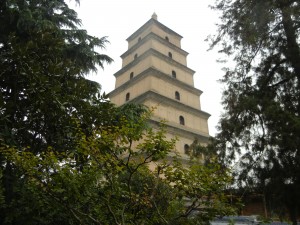
Big Goose Pagoda (pictured above) was finished in 652 to commemorate Xuan Zang’s journey to India, and to house Buddhist scriptures. Chang’an was a crossroads of cultures from India and Central Asia to Japan. All converged there and created some of the greatest glories in China’s cultural history. But there were also lots of social tensions. There was never a dull moment in Tang Chang’an. [click to continue…]
by bria4123 on March 21, 2012
A traditional Islamic community’s skyline suggests hidden depths.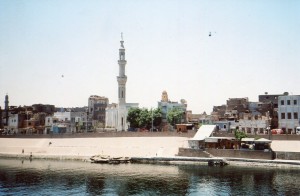
The narrow winding streets don’t offer a long linear perspective that lets you make sense of a big section of the whole. The most prominent building is the mosque’s minaret. So far, we’re on the same ground as medieval European towns, which were dominated by church spires. But Islamic calligraphy enhances the sense that reality has a lot of inner depth. Let’s try to penetrate some of it. [click to continue…]
by bria4123 on March 20, 2012
I had read about guys like this in books on Chinese art, but I was surprised that there were so many of them.
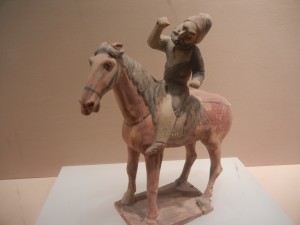
They were made during the Tang Dynasty (618-907). Trade grew along the Silk Road in the early Tang, and through southeastern port cities (especially in the later Tang). Merchants, political envoys, Buddhist pilgrims and vagabonds from Central Asia, Southeast Asia, Korea and Japan went to China to live, and the Tang became the most cosmopolitan dynasty in China’s history. But this guy on the horse isn’t portrayed in a very dignified way. Why is he so animated without any SUV drivers to yell at? His sub-Mandarin bearing suggests mixed feelings about the new diversity. [click to continue…]
by bria4123 on March 19, 2012
The Message meets the Way.
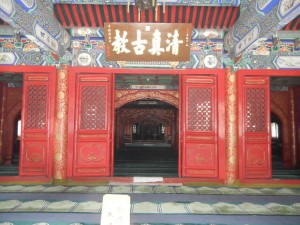
Islam was introduced to China in the seventh century through ports of the southeastern coastal cities of Guangzhou and Quanzhou, and a little later over land through Central Asia, and into the Tang Dynasty’s capital in modern Xi’an. Nearly 1,500 years of cultural contact created one of the world’s most beautiful artistic fusions. I was amazed the first time I saw Chinese Islamic art. [click to continue…]
by bria4123 on March 18, 2012
I recently said that a lot of things in Islamic thought have deeper meanings than what you see on the surface.
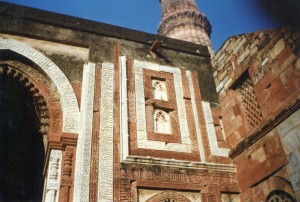
I took the above shot way back in 1996–yes, there were airplanes back then. If you look closely, you can see calligraphy carved all over the wall of this 14th century gatehouse to Qutb Minar, in Delhi, India. That was the first time I saw great Islamic art. It mesmerized me.
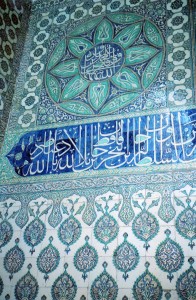
Ditto at the Topkapi (the Sultan’s crash pad in Istanbul) more than 10 years later. Many other Westerners have told me that they also find Islamic designs captivating. There are many reasons why Islamic calligraphy is one of the world’s greatest art forms, and appreciating it is essential for understanding the Islamic world. [click to continue…]
by bria4123 on March 18, 2012
On the surface, nothing could be simpler.
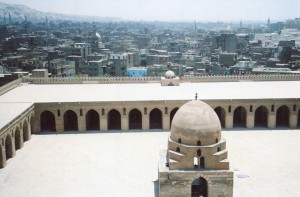
But even the mosque’s courtyard (the Ibn Tulun Mosque’s in the above photo–from the minaret) has deep meanings that take you into the heart of Islam. [click to continue…]
by bria4123 on March 17, 2012
In Islamic thought, a lot of things have deep meanings beneath the surface.
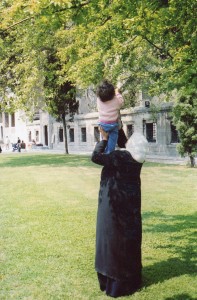
This child is beginning to learn about the Five Pillars of Islam in a mosque in Istanbul. On the surface they might seem simple, but they have layers of meaning that reflect some of the deepest thoughts in the Islamic world. [click to continue…]
by bria4123 on March 17, 2012
I promised you trouble in my last post on Gothic cathedrals. Now it’s time to give it to you.
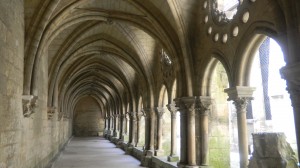 It looks innocent–what could be more peaceful than a cathedral’s cloister? But storms were brewing in places like this in the 12th century that shook Europe. [click to continue…]
It looks innocent–what could be more peaceful than a cathedral’s cloister? But storms were brewing in places like this in the 12th century that shook Europe. [click to continue…]
by bria4123 on March 16, 2012
One of my favorite experiences in Cairo was my walk through the world’s oldest Islamic university, al-Azhar.

Exploring the place took me into Islam’s head and heart. [click to continue…]
by bria4123 on March 16, 2012
You’d think a circle is a circle.
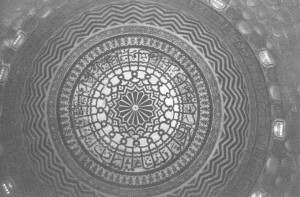
The most basic description of a circle in Western culture is a line around a central point, which is equally distant from the center throughout its length. So, Westerners have usually conceived a circle in terms of its outer edge’s static shape. But other cultures conceive of this basic geometric shape in other ways. Islamic concepts of the circle are some of the world’s richest. We’ll explore them in this post–come into it’s center. [click to continue…]











